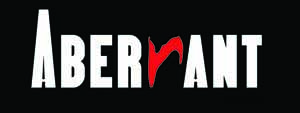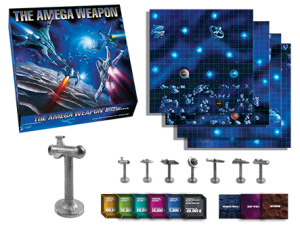Published by The Amega Weapon
Designed by Scott Gower
In The Amega Weapon, players race to build the ultimate weapon. This is done by flying through space and collecting parts from various space stations. There are several hazards in the game like navigating asteroid fields, novae tiles, your opponents, and the dreaded Black Star.
You might find this appealing if you like semi-cooperative games, space themes, and if you don’t mind sitting around the table with friends anywhere from thirty minutes to four hours. Since the game’s release at Gen Con 2014, the designer has added a set of tournament rules based off the feedback of people who have played the game.
I was introduced to The Amega Weapon at Gen Con last year and I had fun playing the game. Since then I have played it about fourteen times. I have discovered that it can be repetitive, it’s always fun, and Scott truly cares about this game. We’ll cover all of those in more detail as we move through this review.
The Components
The game board features art by Greg Winters. Greg is best known for his art for Star Wars, at least that’s how I knew his name. The boards themselves are heavy duty and, as you can imagine, have great art. There are also cards with various effects on them, dice, and ships. The ships are pewter and made in the United States.
Gameplay
Each player starts at one of six star bases, and has one ship that basically has five lives. In the story, every time a captain loses a ship, they start over at their base again because war is now a sport.
Once the game begins, it’s basically a race to obtain all of the pieces of the Amega Weapon. This is done by accomplishing missions and earning enough gowers (money) to buy them. As a captain you will have to visit all of the bases to gather the weapon. You also have some choices to make, like will you attack or avoid your opponents.
Once a player has assembled the Amega Weapon, their new objective is to wipe everyone out! It’s possible that no one manages to assemble the Amega Weapon, in that case you might be the victor because you’re the last ship remaining.
Turn Order
- Draw a mission card or dock at a star base
- Move
- Attack
- Move the Black Star
- Draw
If you have no active mission, you may dock at a space station and purchase a part of the Amega Weapon. You can continue to dock at star bases until you have exhausted all of your resources. If you manage to complete construction of the weapon, then you can attack your opponents; if not, it’s time to draw a mission card and earn more gowers.
Movement
Movement is pretty straightforward, you roll 2d6 and move your ship that many squares. There are a couple of hazards to avoid though, like novae and the asteroid field. Movement is not forgiving, if you put your ship on a square – even if you’re just passing through – you moved into it, so be careful. If you land on a red dot, even if repulsed into it in combat, you have to draw a Deep Space card and resolve it. Deep Space cards can be good or bad. They often include a fame or fortune kind of story to go with the action to be taken. Avoid the Novae squares because they destroy your ship, even if you get knocked into them in combat.
Navigating an asteroid can be unforgiving. If you move through a square that has even a tiny bit of rock in it, then you have hit the ‘roid and must draw an asteroid card. I would say roughly 75% of these are not good for you.
Combat
There are two parts to combat, conventional fire and the Amega Weapon. You may not fire onto a planet or star base. Asteroids, planets, and novae also block line of sight. I should note that you may only fire in straight lines, so there are blind spots that you can hide in.
With conventional weapons you can fire no more than 4 squares. At close range you can damage shields or ships, but at longer ranges you can “stun” the ship, forcing your opponent to skip a turn.
The Amega Weapon has a range of up to 15 squares if targeting a ship that hasn’t been fitted with the Amega Weapon, or 10 squares against one that has. Its damage effects are anything from complete destruction to the loss of a turn, again this is dependent upon the range.
When players are engaged in combat, they will both roll 1d6. The attacking player will add 1 to the die roll. If the attacker’s modified roll is greater than the defender’s roll then he has hit the enemy, and will consult the battle resolution chart for the outcome. If the defender wins, he has the option to counter attack. In the event of a tie, the players have hit each other at the same time and they are each forced one square away from each other.
The Black Star
This is the craziest element in the game. The Black Star is a powerful cosmic force that favors no one and is more destructive than the Amega Weapon. The Blacks Star is kind of like a space tornado, it destroys everything in its path and one square to each side. To move the Black Star, you roll a d10 and a d20. The d10 will determine the direction it moves, while the d20 will tell you how fast it moves.
My Thoughts
As I said before, I have played this game about fourteen times and I have won and lost just about every way the game offers. The game board is large, which can lead to some repetitious and long games. The Amega Weapon is a game that has a lot of random elements that can make or break your plan, especially the Black Star. That thing must really have a mind of its own or the spirit of a shark because it can be all the way across the table, but before you know it your ship has been gobbled up. It no longer surprises me that when these random elements occur, just about everyone laughs. We have had a good time every time we play because of the slap stick game and comments we create. It took me a while to figure out that the best part of this game is the laughter, because I was focused on understanding what made the game work. Now I know that the game is a blast with big brothers that “heckle” you.
I mentioned the game can be long, but Scott has recently created some tournament rules that really speed the game up. The changes include a scoring system that doesn’t necessarily make this a “last man standing” kind of a game. Plus he has modified the rules for missions so that you and sometimes even other players might know your missions. These changes have added a lot more strategy to the game and make it more aggressive.
While speaking with Scott last year at Gen Con, he told me there is potential for 2 or 3 expansions written into the background story for the game. He has shared some of his ideas with me and I think that The Amega Weapon will have a good future.




Sorry, the comment form is closed at this time.